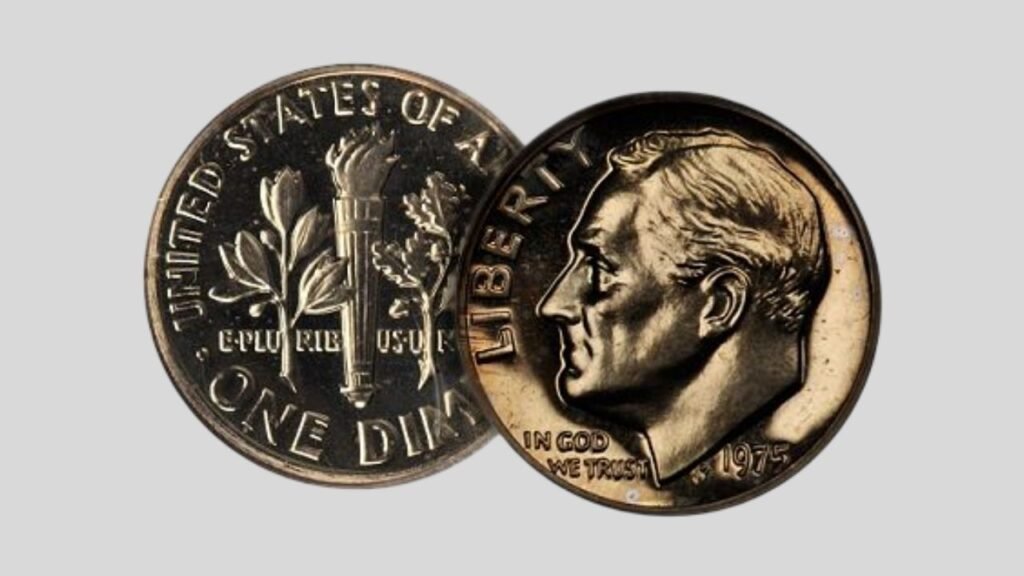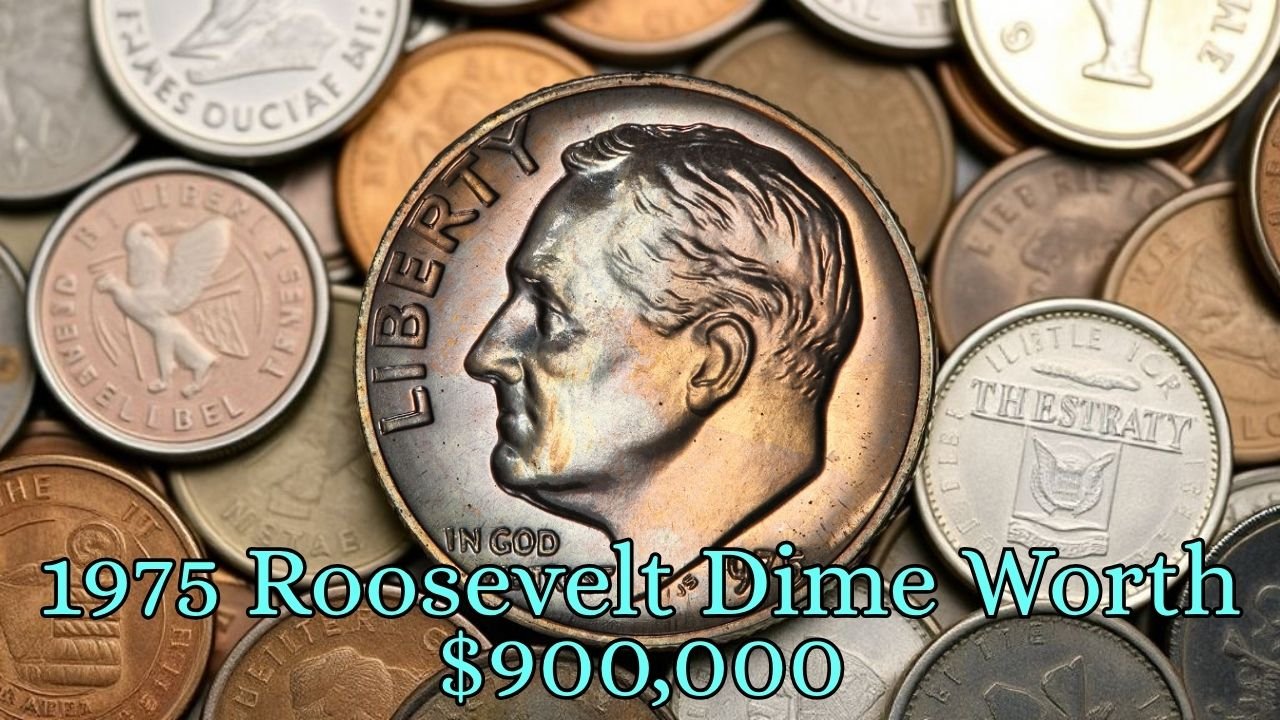Over the years, rumors and sensational headlines have circulated claiming that a 1975 Roosevelt dime sold (or should sell) for $900,000. Such figures are engaging and seize attention. But whilst one investigates the numismatic document, there’s no verifiable proof that any 1975 Roosevelt dime has ever fetched $900,000 at auction or private sale.
What is proper is that a very rare “blunders” version of the 1975 Roosevelt dime — the 1975 “No S” Proof Roosevelt dime — has certainly commanded very high charges, even though inside the realm of half 1,000,000 USD, now not near $900,000.
What Is the 1975 “No S” Proof Roosevelt Dime?
To apprehend its rarity, we need some history on U.S. Dimes and evidence coinage:
- The Roosevelt dime (providing Franklin D. Roosevelt) has been minted considering the fact that 1946.
- From 1968 onward, proof coins struck at San Francisco usually deliver an “S” mint mark, indicating the San Francisco Mint.
- In 1975, the San Francisco Mint struck approximately 2.84 million evidence units, every containing a evidence Roosevelt dime among other coins.
- Among those proof dimes, two specimens (and only two confirmed so far) were found lacking the “S” mint mark on the obverse — hence the name 1975 “No S” Proof Roosevelt Dime.
- The missing mint mark is a minting error: the dies used to strike proof dimes were supposed to carry an “S,” but in these rare cases that didn’t happen (or those dies escaped detection).
Because proof coins are not meant for circulation, and because minting errors are often caught and corrected, such mistakes are exceedingly rare. That extreme rarity is the root of the value.
Auction Records & Realized Prices
Let’s look at what is documented:
- In 2019, one of the two known 1975 No S proof dimes sold for $456,000 (including buyer’s premiums) at a Heritage Auction.
- More recently, in an online auction in October 2024, the other known specimen (nicknamed the “Ruth E.” dime) realized $506,250 (including premium).
- That sale set a new record for that particular coin error, bringing attention back to this niche of modern-coin rarities.
Thus, the highest confirmed sale is around $506,250 — well under the oft-quoted $900,000. Because only two are known, there is also no competitive compendium of sales pushing the market higher (yet). That means claims of $900,000 likely stem from speculation, misquoting, or confusion with other rare coin stories.

Why Collectors Are Wild About It
Why spend millions of dollars for a dime? Several factors converge to make the 1975 No S proof dime a “collector’s dream”:
- Extreme rarity
With just two verified examples, the scarcity is immediate and absolute. No known third specimen has been authenticated. - Modern coin error prestige
Most extremely valuable coin errors come from older issues where quality control was less exacting. Having a modern (1975) error of this magnitude is unusual and intriguing. - High collector demand
Among U.S. coin collectors, famous modern rarities draw global interest. The October 2024 auction for the No S dime drew more than 200 bids from collectors worldwide. - Provenance and story
One of the dimes was held privately for decades, even kept in a vault by a farming family in Ohio before its 2024 sale. That backstory adds to the mystique. - Potential for future discoveries
Since mint records are incomplete and errors occasionally are unearthed later, the possibility (however remote) of a third example keeps hope alive among collectors. If a third specimen were authenticated, it might spur new competition and higher valuations.
Why the “$900,000” Figure Is Misleading
Because so few of these dimes exist, speculative projections are sometimes floated by dealers or enthusiasts, suggesting that a “perfect” or uniquely graded specimen might reach $700,000–$900,000 or more. But until such a specimen is proven and sold, these figures remain hypothetical.
Here are a few caveats:
- The current high sales are in the ~$500,000 range, not near $900,000.
- Coin markets depend heavily on condition, grading, buyer demand, and auction dynamics—not just rarity.
- Without graded or auction-verified sales near $900,000, such claims are speculative or promotional.
So while $900,000 makes for a compelling headline, it lacks substantiation to date.
What If You Think You Have One?
If you discover a 1975 Roosevelt dime and it appears to lack the “S” mint mark, here’s what to do:
- Do not spend it — Treat it with utmost care; this is the kind of coin you’d want to protect, not discard.
- Photograph it carefully — Under strong light and magnification, document the obverse area where the “S” would normally appear.
- Submit it to a respected grading service — Organizations like PCGS or NGC can authenticate, grade, and encapsulate (certify) the coin.
- Seek expert numismatic opinions — Specialists in modern U.S. coin errors can help assess the authenticity and market potential.
- Consider auction consignment — If genuine and well graded, a major auction house with numismatic expertise is the ideal venue for selling.
Conclusion
The story of the 1975 “No S” Proof Roosevelt Dime is a compelling mix of minting mystery, extreme rarity, and collector fascination. While rumors of a $900,000 sale are not backed by evidence, the coin’s true auction records—around $456,000 to $506,250 — are nonetheless extraordinary for a modern dime.
This dime commands such attention not because of intrinsic metal value, but because it represents a rare window into what can go wrong at a mint, even in modern times. For collectors, that error, the story behind its survival, and the tension of “only two known” make it a dream piece. Whether future discoveries or unexpected auctions drive the high end further upward remains to be seen—but, for now, it stands as one of the crown jewels of U.S. modern coin errors.
FAQ’s
Why are there not many 1975 No-S dimes?
The mistake was picked up early in production, and the majority were probably caught and destroyed, so only two are known to have reached the market.
How do I know if I have a 1975 No-S Roosevelt Dime?
Look for the mirror polish finish of proof coins and lack of the ‘S’ mint mark. If your 1975 dime doesn’t have the mint mark but isn’t proof finished, it’s probably a common Philadelphia variety.
What do I do if I believe I have a rare coin?
Have a legitimate coin dealer or professional grading service authenticate and grade the coin.
Are there any other No-S proof coins that are worth money?
Yes
